The rococo period is known for its extravagance, standing out as the crescendo of the baroque era before neoclassicism put an end to its unblushing display of affluence. From the pastoral scenes of Watteau to the ribband furniture of Thomas Chippendale, rococo can be found in all aspects of mid to late 18th century design.
 Above: a selection of rococo decorative arts, including a painting by Anton Raphael Mengs and a tapestry designed by François Boucher
Above: a selection of rococo decorative arts, including a painting by Anton Raphael Mengs and a tapestry designed by François Boucher
But what are the defining characteristics of true rococo style, and how was it developed? This article will look into the rise and fall of a truly lavish time in art history. We will also discuss the ways in which rococo paintings, ornaments and interiors can be sensitively restored and cared for by our highly trained conservators.
 Above: a detail from Concert Champêtre by Jean-Baptiste Pater, 1734
Above: a detail from Concert Champêtre by Jean-Baptiste Pater, 1734
What does rococo mean?
Rococo comes from the word rocaille, this was originally a method of decoration using shells, stones and pebbles mixed with cement, as you might come across in the grottos of aristocratic gardens. Later, the term rocaille is used to describe a style of French decorative art featuring a multitude of curves, swirls and elements inspired by nature, such as acanthus leaves and seashells. Whilst rocaille is often balanced and symmetrical in design, rococo has more of a free-flowing effect with an extra emphasis on over-decoration.
 Above: examples of the rocaille shapes and style on gilt bronze decorative features
Above: examples of the rocaille shapes and style on gilt bronze decorative features
The rococo period is usually defined as 1740 to 1770, taking over from the baroque Louis XIV style and later being replaced with toned-down neoclassical tastes.
What is the difference between baroque and rococo?
Whilst baroque and rococo have some overlapping features, rococo has more emphasis on natural shapes – often choosing the flow of leaves, vines, flowers and curves over the symmetry that might have previously been expected from interior design. Garlands or festoons of leaves and flowers can be seen in paintings, sculptures and decorative architectural features, as well as C and S shapes commonly recurring in all aspects of art and design.
 Above: a wall tapestry after a design by Robert Adam, featuring floral garlands and scenes by Boucher, 1763
Above: a wall tapestry after a design by Robert Adam, featuring floral garlands and scenes by Boucher, 1763
Rococo may also have inclusions of Chinoiserie or Japonism, as many Asian artforms in this period were restricted to only the very wealthy and therefore carried a sign of status. The picture of Chinese life found in typical Chinoiserie patterns and scenes is very close to the pastoral settings found in many rococo paintings.
 Above: a detail from a French ceiling design with Chinoiserie features, 18th century
Above: a detail from a French ceiling design with Chinoiserie features, 18th century
Rococo oil paintings
Oil paintings in the rococo period had a focus on natural, arcadian environments and the romanticism of pastoral life – an aristocratic view of peasants working the land in seemingly carefree lives without regal rules and expectations. You will also come across mythological scenes and religious art with a soft, pastel palette of creams, pinks, light blue skies and pearlescent tones. Whilst both France and Germany have spectacular in-situ examples of rococo painting, it was French artists, with the exception of Italian master Tiepolo, that dominated the market.
 Above: a detail from The Interrupted Sleep by François Boucher, 1750
Above: a detail from The Interrupted Sleep by François Boucher, 1750
The fête galante style is an iconic part of rococo painting, this was a category created in the French academy in 1717 to describe the work of Antoine Watteau (1684-1721), who had a unique mixture of romantic landscapes and genre scenes that often depicted a fête champêtre – a pastoral festival held by nobility, often in the grottos and follies of landscape gardens.
 Above: a detail from The French Comedians by Antoine Watteau, 1720
Above: a detail from The French Comedians by Antoine Watteau, 1720
As Watteau worked for patrons he required the ability to include them in his work, but also wanted to elevate his art by alluding to allegorical history paintings – the fête galante allows him to bring French aristocracy into the arcadian settings usually found in mythological works.
 Above: a detail from an engraving after Watteau’s masterpiece L’Embarquement pour Cythere, 1717
Above: a detail from an engraving after Watteau’s masterpiece L’Embarquement pour Cythere, 1717
The second name in rococo art is Francois Boucher (1703-1770), one of the most celebrated painters of the 18th century. Boucher worked in both portraiture and history painting, composing classical scenes of gods, goddesses and aristocratic figures, often with an intimate and erotic focus rather than the grand drama of typical mythology. It was Boucher’s patronage from Marquise de Pompadour, a chief mistress of Louis XV, that furthered his career and the grandeur of the rococo form in Versailles.
 Above: a detail from Shepherd’s Idyll by Boucher by François Boucher, 1768
Above: a detail from Shepherd’s Idyll by Boucher by François Boucher, 1768
Further artists you will find in the rococo genre include:
- Jean François de Troy (1679-1752)
- Johann Baptist Zimmermann (1680-1758)
- Jean-Baptiste van Loo (1684-1745)
- Jean-Marc Nattier (1685-1766)
- François Lemoyne (1688-1737)
- Nicolas Lancret (1690-1743)
- Charles-Antoine Coypel (1694-1752)
- Jean-Baptiste Pater (1695-1736)
- Giovanni Battista Tiepolo (1696-1770)
- Charles-Joseph Natoire (1700-1777)
- Charles-André van Loo (1705-1765)
- Louis-Michel van Loo (1707-1771)
 Above: a detail from The Two Sisters by Jean Honoré Fragonard, 1769-70
Above: a detail from The Two Sisters by Jean Honoré Fragonard, 1769-70
Rococo interiors, furniture and decorative objects
Rococo interiors were full of many beautiful items and materials featuring gold leaf, marble, frescos, and intricately carved furniture. There would have also been aspects of stucco decoration either in white or gold leaf, as well as decorative wall reliefs and architectural details such as corinthian or composite columns.
 Above: a selection of rococo decorative objects including a candelabrum, a wall clock, a porcelain centrepiece by Höchst Manufactory and a wall mount with porcelain and gilt bronze features
Above: a selection of rococo decorative objects including a candelabrum, a wall clock, a porcelain centrepiece by Höchst Manufactory and a wall mount with porcelain and gilt bronze features
Ceramic items from this period often feature bright colours and gilding, either in painted details or ormolu (gilt bronze) areas. Commedia dell’arte figurines by manufacturers such as Meissen were popular and large ceramic displays were often created for dining table centrepieces.
 Above: detail of a fire screen from 1735-1740
Above: detail of a fire screen from 1735-1740
Gilt bronze ‘ormolu’ and decorative metal aspects could be found throughout interiors, in candelabras, wall sconces, and sculptures. Furniture with ormolu decoration is typical of the rococo style, often in ribband patterns or curved, almost natural shapes. Wooden furniture is typically made of mahogany, oak or walnut, though more exotic materials may have been sourced.
 Above: a pair of vases from 1762 by Chelsea Porcelain Manufactory and a console table with gilt wood and a brocatello marble top
Above: a pair of vases from 1762 by Chelsea Porcelain Manufactory and a console table with gilt wood and a brocatello marble top
As well as gilt bronze, furniture would have also featured lacquer work inspired by Asian design. This Chinoiserie style was often infused with gilt rococo details. Thomas Chippendale’s catalogue of styles entitled The Gentleman and Cabinet Maker’s Director was first published in 1754, featuring many rococo and Chinoiserie designs.
 Above: a selection of Chippendale furniture designs
Above: a selection of Chippendale furniture designs
Famous rococo designers include:
- Charles Cressent (1685-1768)
- Jean-Pierre Latz (1691-1754)
- Juste-Aurèle Meissonnier (1695-1750)
- Michael Kimmel (1715-1794)
- Thomas Chippendale (1718-1779)
- Jean-François Oeben (1721-1763)
- Roger Vandercruse Lacroix (1728-1799)
- John Linnell (1729-1796)
 Above: a selection of rococo ceramics including figurines and snuff boxes
Above: a selection of rococo ceramics including figurines and snuff boxes
Rococo art and design restoration
Our trained team is able to restore a wide range of materials due to their different specialisms. Our studio is home to frame, painting, furniture, ceramic, paper and textile conservators, working together with museum-level expertise to provide care and conservation to historic objects.
 Above: an 18th century portrait with fire damage, before and after restoration in our studio
Above: an 18th century portrait with fire damage, before and after restoration in our studio
18th century artworks are popular in our restoration studio due to their vulnerability in old age and popularity as antiques. You can read more about 18th century portrait care and restoration here. Ceramics with gilded features and fragile porcelain designs can be professionally restored, for more information see our Meissen article.
 Above: a Meissen figurine before and after restoration in our studio
Above: a Meissen figurine before and after restoration in our studio
Our furniture experts are able to restore wooden and lacquer surfaces, as well as gilt areas. Our specialist frame conservators have expertise in applying gold leaf with correct levels of ageing and effect to suit your frame, furniture or decorative object. You can learn more about gold leaf care and restoration here.
 Above: a gilt frame before and after restoration treatment in our studio
Above: a gilt frame before and after restoration treatment in our studio
Conservation work to buildings and interiors can also take place in situ, such as restoring stucco features, relief panels, and gold leaf and ceiling murals. You can find out more about our fresco restoration work here.
 Above: our team cleaning a ceiling mural on site
Above: our team cleaning a ceiling mural on site
How can we help?
If you have an 18th century artwork, piece of furniture, ceramic or specialist item that requires care, please contact our expert team for further guidance and advice. Email us via [email protected] or call 0207 112 7576

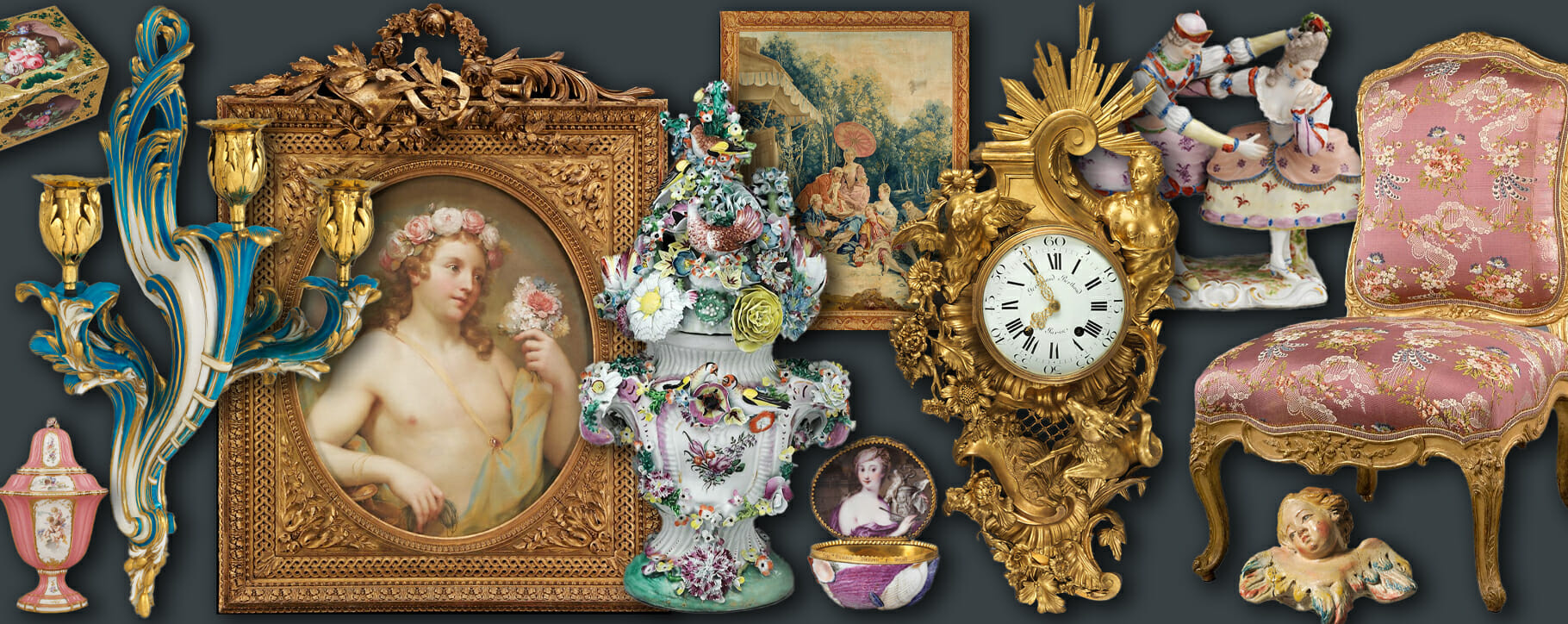 Above: a selection of rococo decorative arts, including a painting by Anton Raphael Mengs and a tapestry designed by François Boucher
Above: a selection of rococo decorative arts, including a painting by Anton Raphael Mengs and a tapestry designed by François Boucher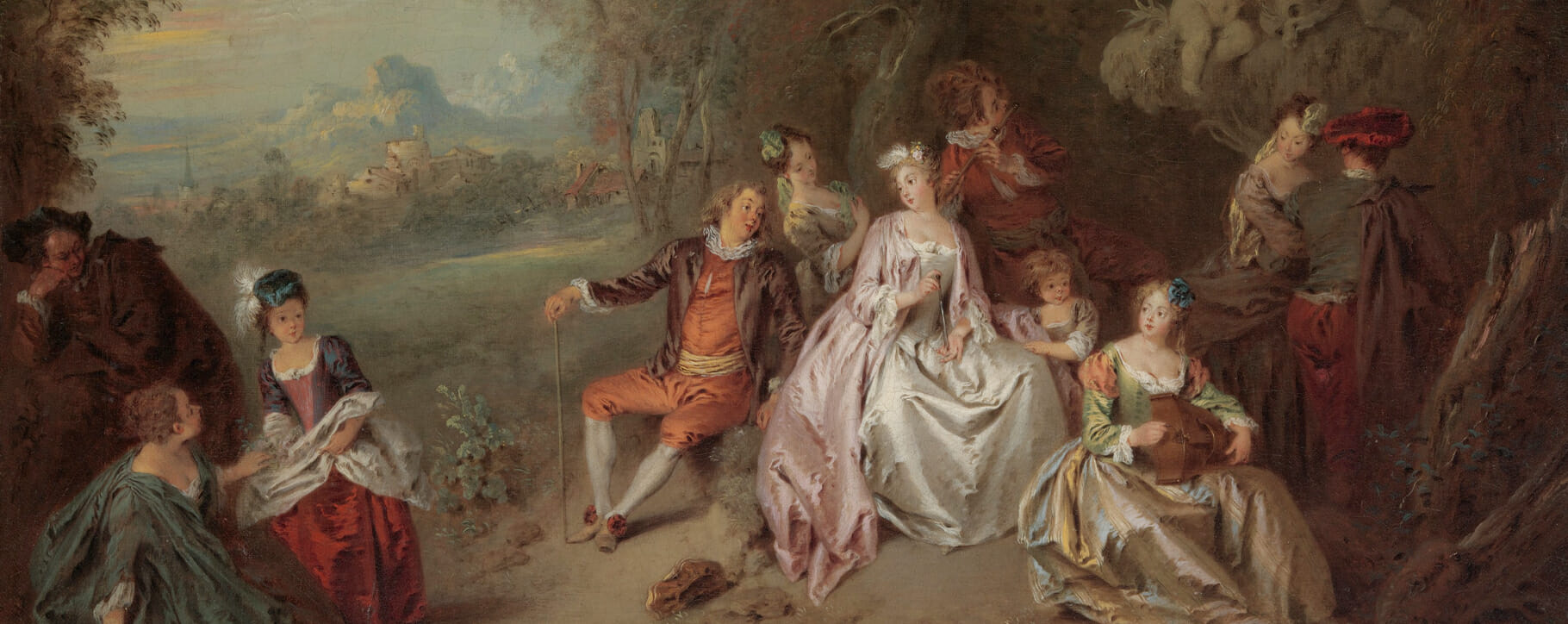 Above: a detail from Concert Champêtre by Jean-Baptiste Pater, 1734
Above: a detail from Concert Champêtre by Jean-Baptiste Pater, 1734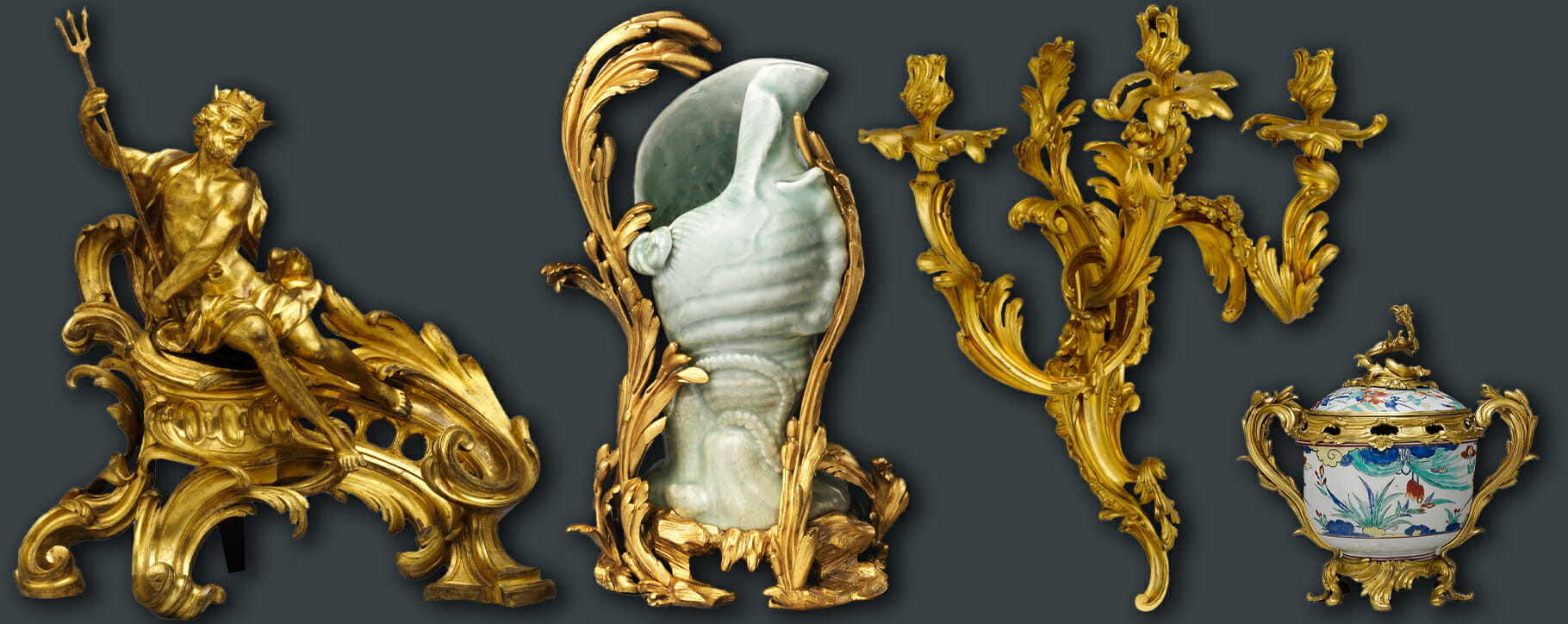 Above: examples of the rocaille shapes and style on gilt bronze decorative features
Above: examples of the rocaille shapes and style on gilt bronze decorative features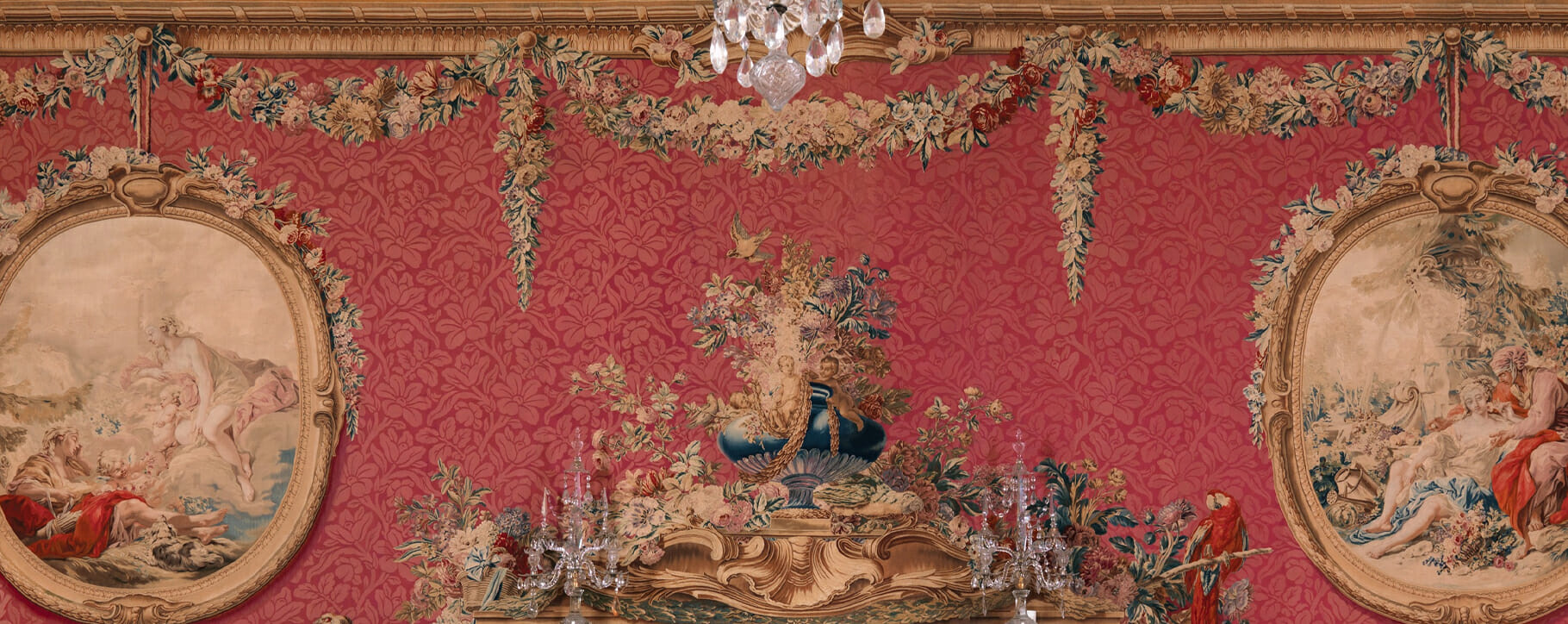 Above: a wall tapestry after a design by Robert Adam, featuring floral garlands and scenes by Boucher, 1763
Above: a wall tapestry after a design by Robert Adam, featuring floral garlands and scenes by Boucher, 1763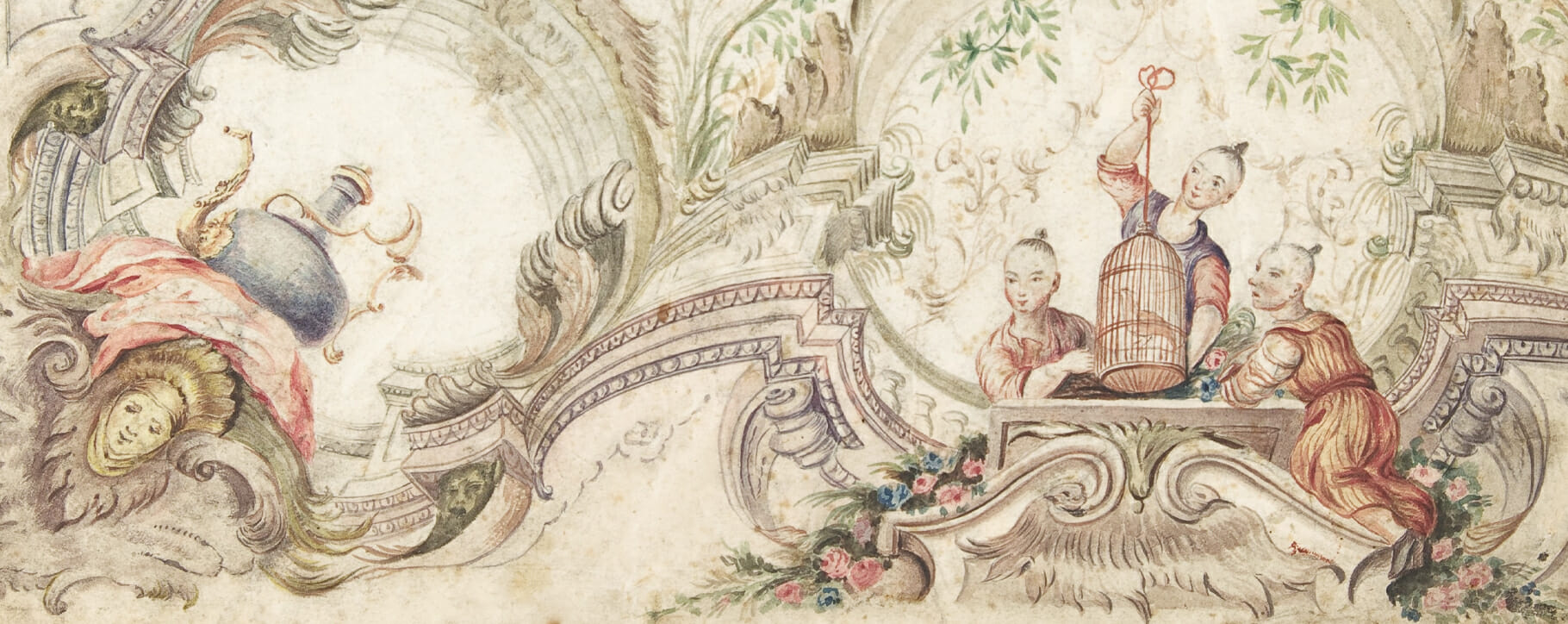 Above: a detail from a French ceiling design with Chinoiserie features, 18th century
Above: a detail from a French ceiling design with Chinoiserie features, 18th century Above: a detail from The Interrupted Sleep by François Boucher, 1750
Above: a detail from The Interrupted Sleep by François Boucher, 1750 Above: a detail from The French Comedians by Antoine Watteau, 1720
Above: a detail from The French Comedians by Antoine Watteau, 1720 Above: a detail from an engraving after Watteau’s masterpiece L’Embarquement pour Cythere, 1717
Above: a detail from an engraving after Watteau’s masterpiece L’Embarquement pour Cythere, 1717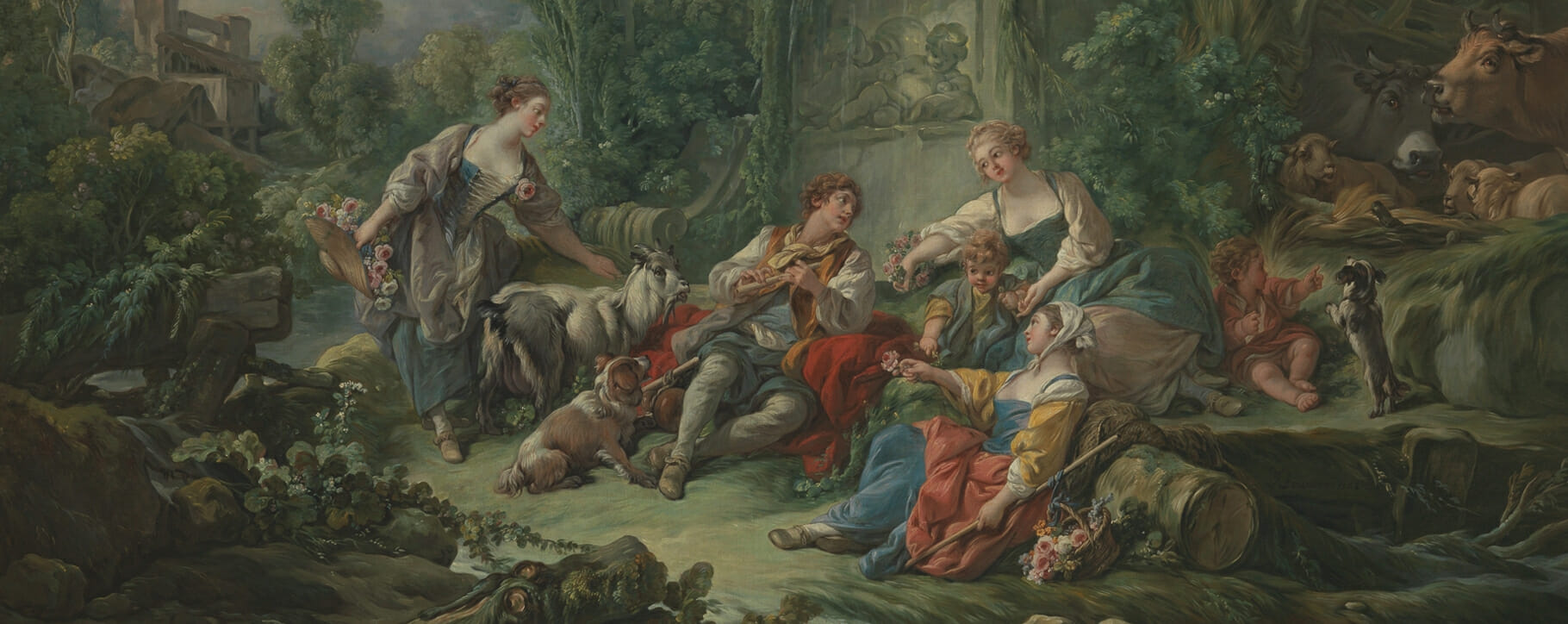 Above: a detail from Shepherd’s Idyll by Boucher by François Boucher, 1768
Above: a detail from Shepherd’s Idyll by Boucher by François Boucher, 1768 Above: a detail from The Two Sisters by Jean Honoré Fragonard, 1769-70
Above: a detail from The Two Sisters by Jean Honoré Fragonard, 1769-70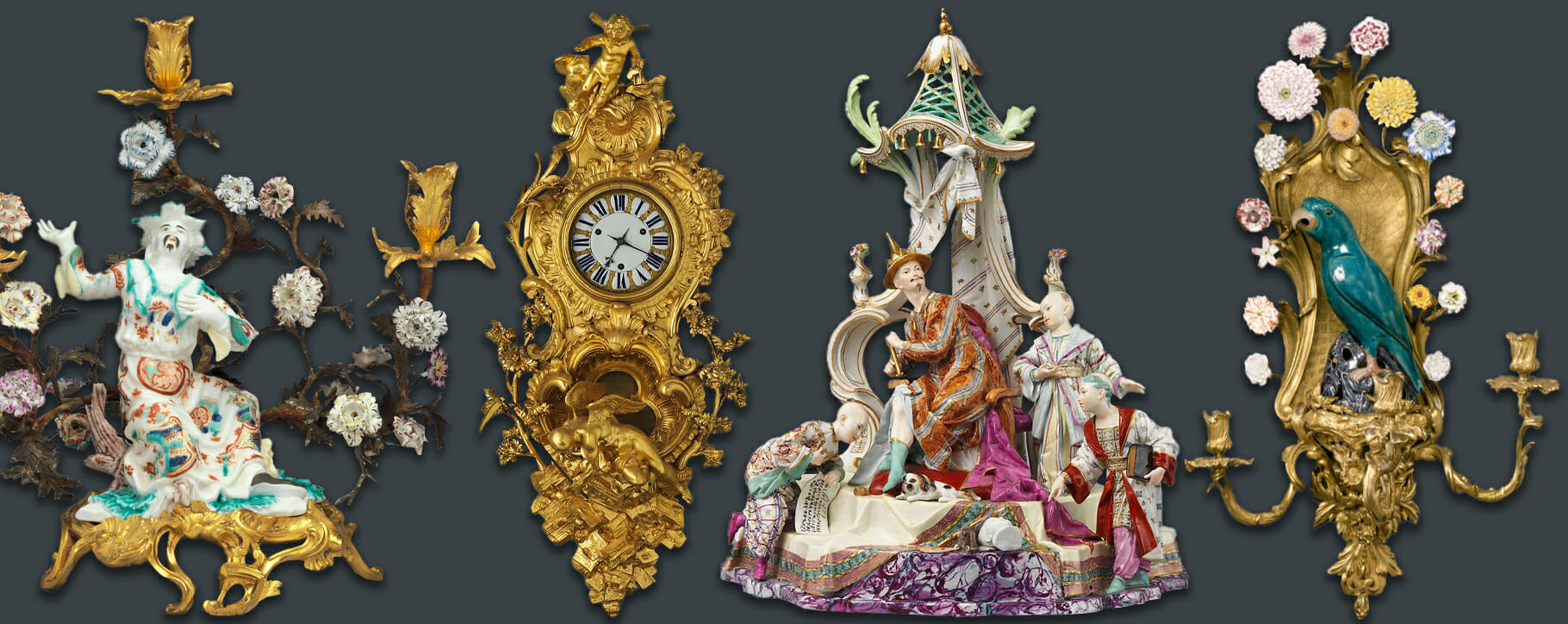 Above: a selection of rococo decorative objects including a candelabrum, a wall clock, a porcelain centrepiece by Höchst Manufactory and a wall mount with porcelain and gilt bronze features
Above: a selection of rococo decorative objects including a candelabrum, a wall clock, a porcelain centrepiece by Höchst Manufactory and a wall mount with porcelain and gilt bronze features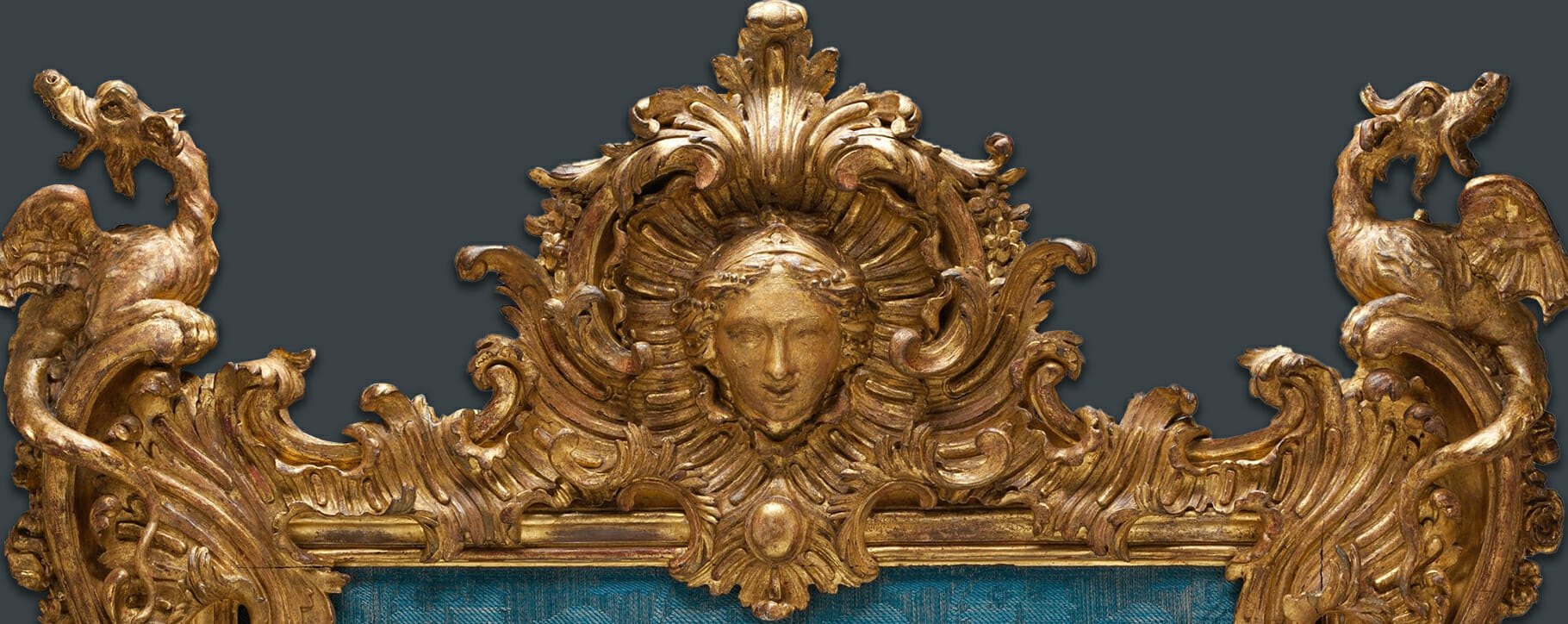 Above: detail of a fire screen from 1735-1740
Above: detail of a fire screen from 1735-1740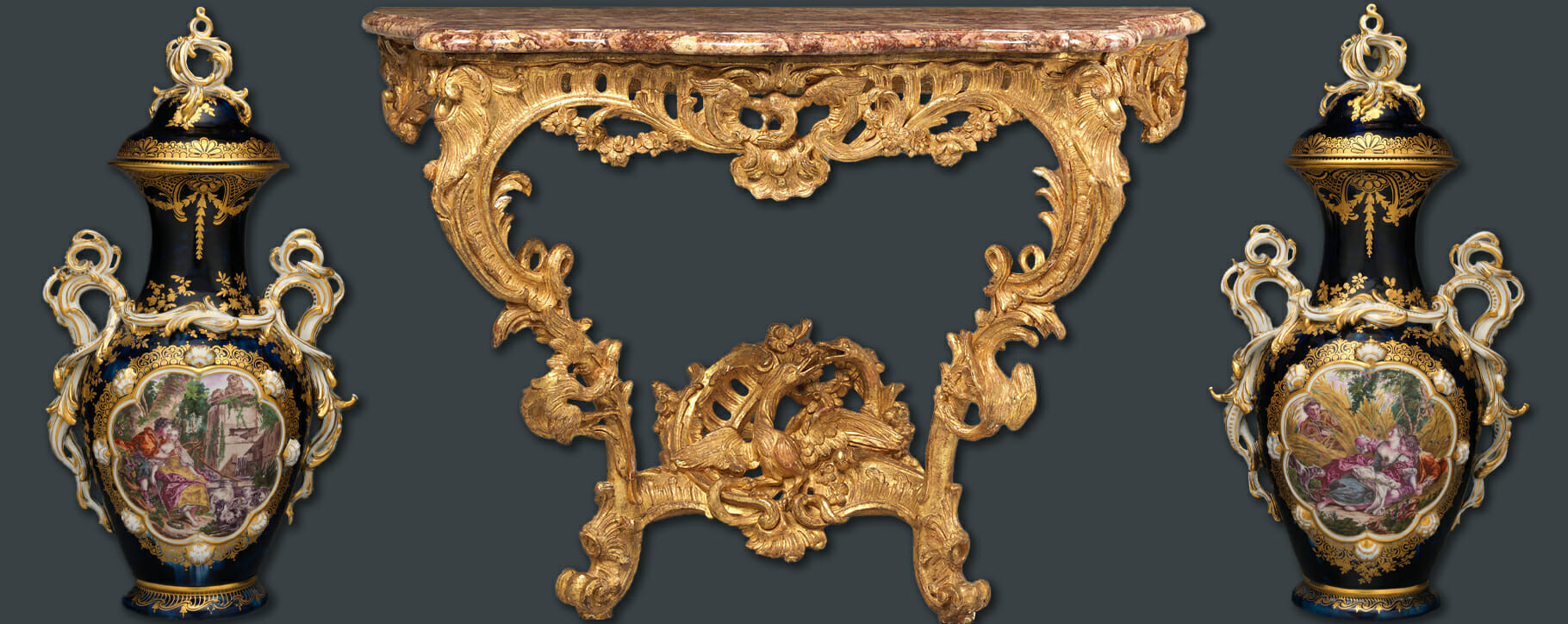 Above: a pair of vases from 1762 by Chelsea Porcelain Manufactory and a console table with gilt wood and a brocatello marble top
Above: a pair of vases from 1762 by Chelsea Porcelain Manufactory and a console table with gilt wood and a brocatello marble top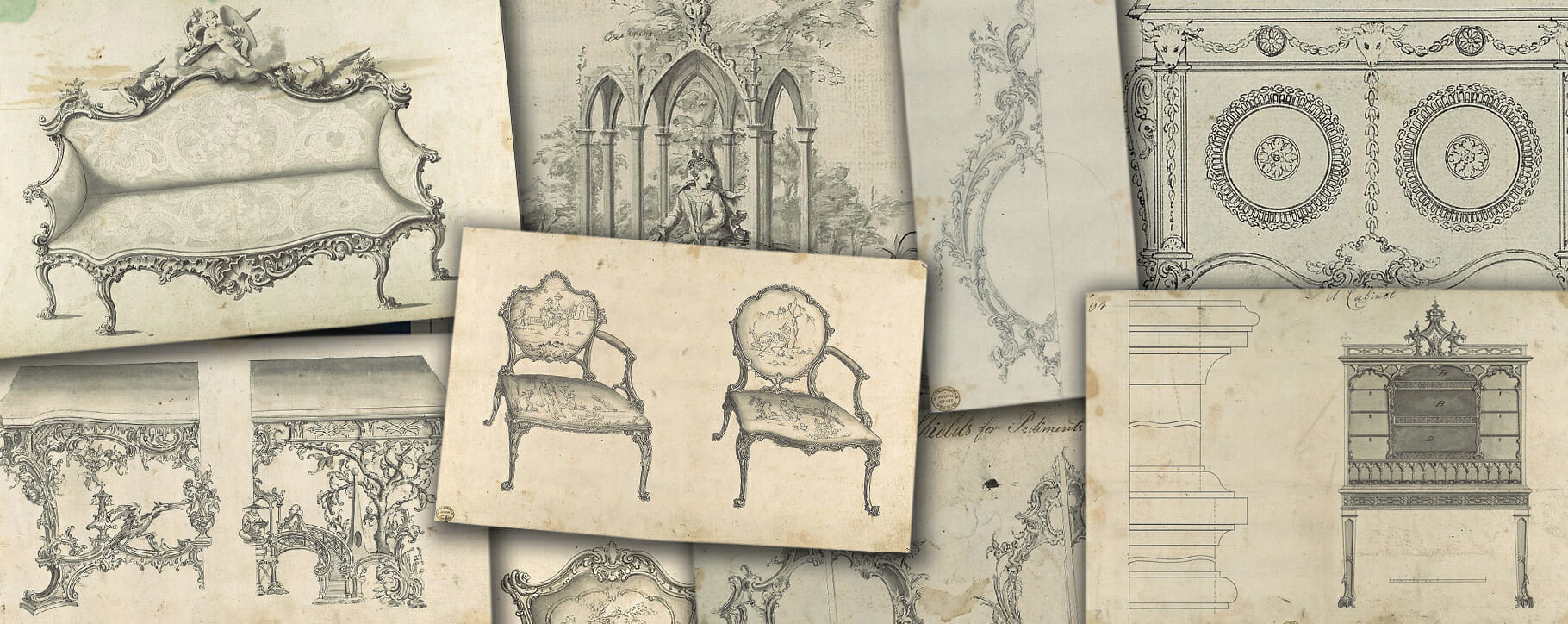 Above: a selection of Chippendale furniture designs
Above: a selection of Chippendale furniture designs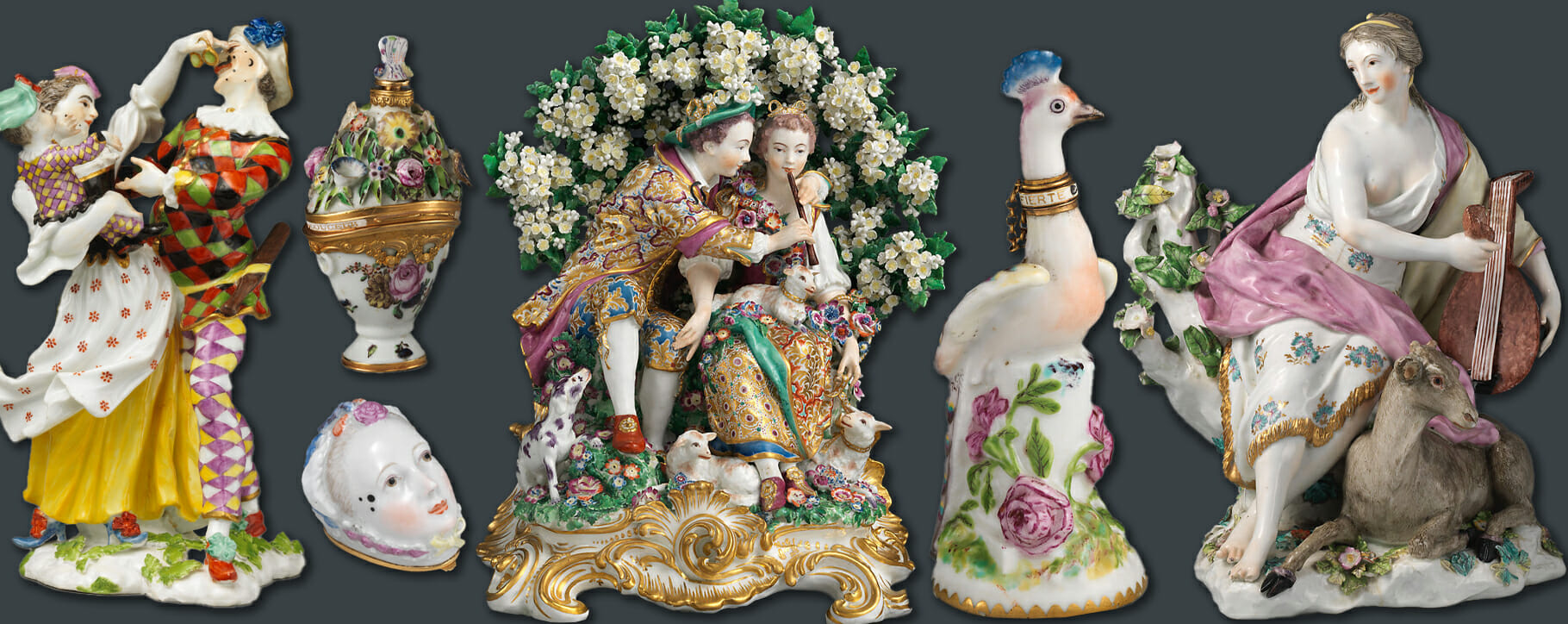 Above: a selection of rococo ceramics including figurines and snuff boxes
Above: a selection of rococo ceramics including figurines and snuff boxes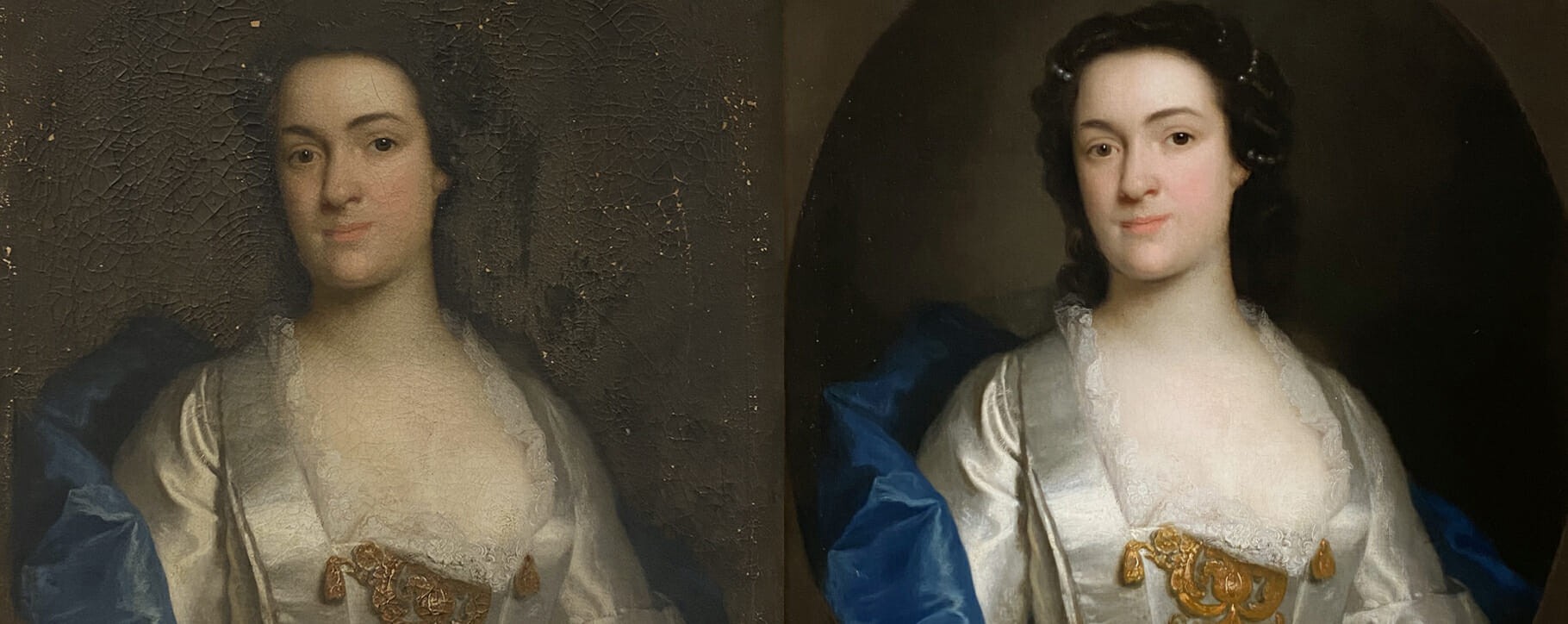 Above: an 18th century portrait with fire damage, before and after restoration in our studio
Above: an 18th century portrait with fire damage, before and after restoration in our studio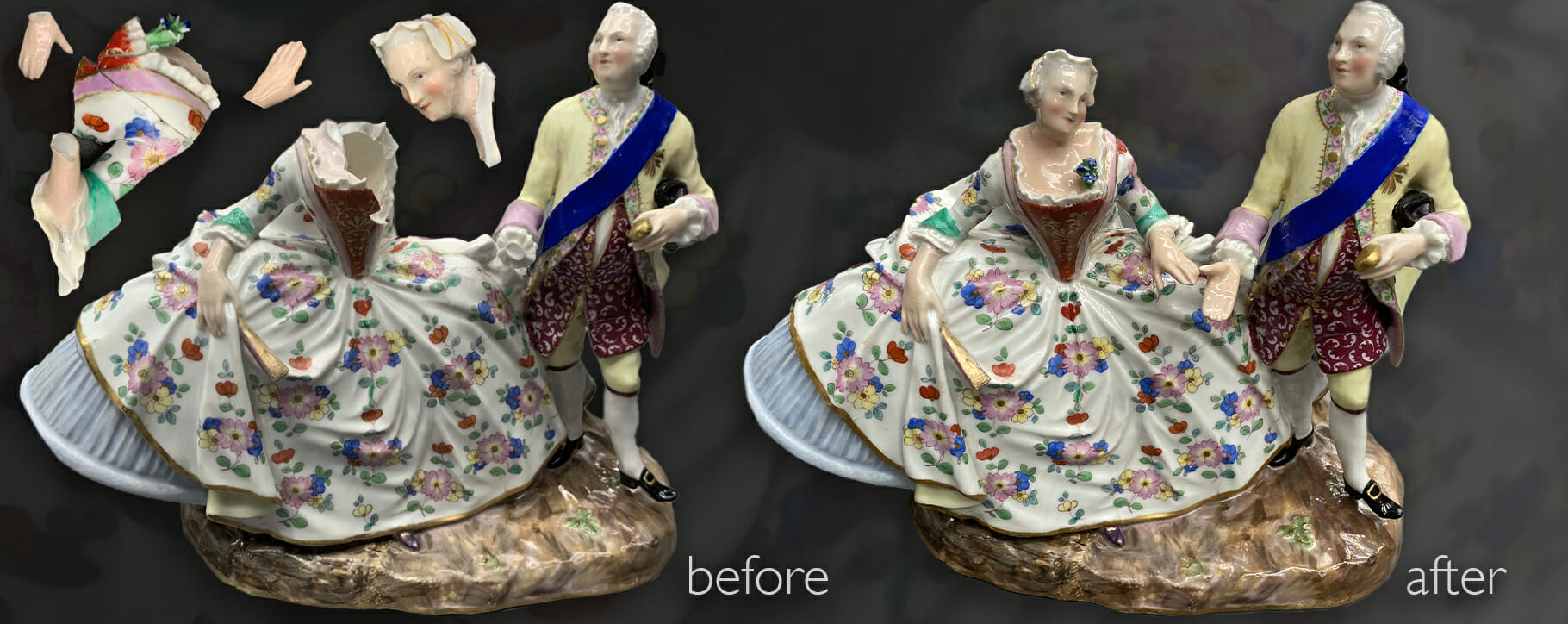 Above: a Meissen figurine before and after restoration in our studio
Above: a Meissen figurine before and after restoration in our studio Above: a gilt frame before and after restoration treatment in our studio
Above: a gilt frame before and after restoration treatment in our studio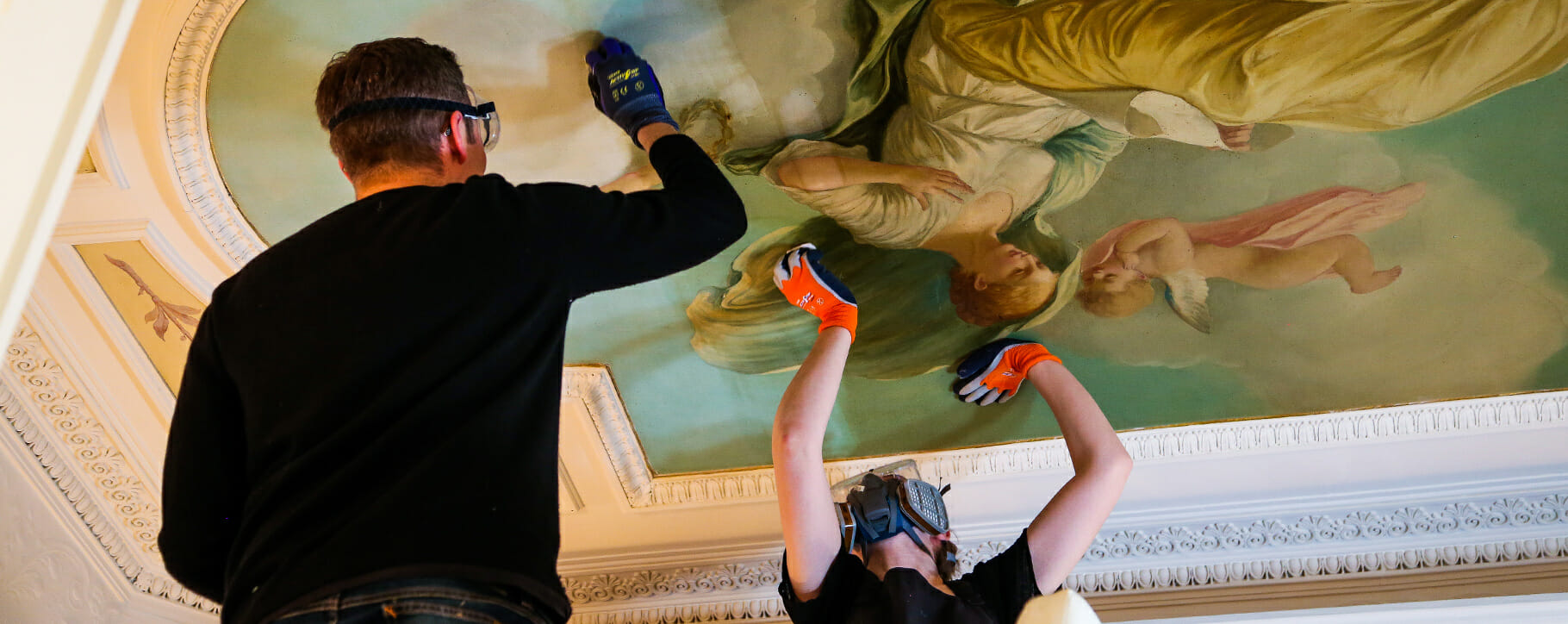 Above: our team cleaning a ceiling mural on site
Above: our team cleaning a ceiling mural on site




